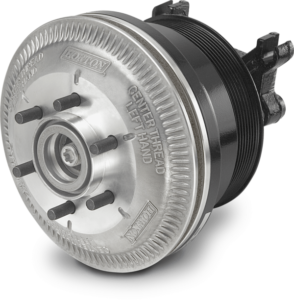The Horton fan clutch has a critical role in a truck, yet it is the most ignored and least looked after parts. In this element, we’ll clarify how the Horton fan clutch functions, what upkeep it requires and essentially what to watch out for.
A Horton fan clutch’s prime function is to engage and disengage the engine fan with a clutch controlled by an air-actuated solenoid valve. On a modern vehicle the solenoid receives signals to turn on and off from the engine’s ECU. On older trucks, the signals are sent from the temperature sensor.
The clutch engages and makes the fan turn when the valve opens, sending air pressure to overcome a spring and push the Piston Friction Disc (PFD) against the friction material. It disengages when the valve closes, allowing the clutch solenoid to exhaust air and let the spring return.
Most vehicles also have a manual override switch which will allow the driver to activate the fan on the approach to a hill to bring the engine temperature down. Conversely, on a long descent, a professional driver will manually activate the fan to help aid engine retardation because the fan soaks up 30 to 40 horsepower.
How the Horton fan clutch functions
In case of fan clutch slippage, heat develops at the external edge of the Piston Friction Disk (PFD). This warmth works its way toward the focal point of the fan clutch. When damaging levels of heat reach the System Sentry the fuse will melt. This allows air pressure in the fan clutch to drop, disengaging the fan clutch immediately. When the System Sentry has discharged the fan clutch, it has done this to protect you. This defensive activity additionally cautions you that there is an issue, so you can investigate and repair the issue instantly.
Fan Blades
Fan blades should be checked for clearance to the radiator, shroud and engine parts. Check, find and evacuate anything that might be a hindrance to the fan blade. Watch that there are no breaks or parts in the fan blades that may cause the fan to run out of balance.
Clutch Slippage
A fan clutch needs 100 psi (6.8 bar) for a strong engagement. Search for an issue that is causing partial engagement. Usually air leaking past the solenoid valve seals into the airline causing a pressure build-up. Is there a pressure drop causing partial disengagement? This usually is caused by an inoperative solenoid, airline blockage, up-stream air leaks, air leaks from the fan clutch body itself or low air pressure.
Maintenance of Horton fan clutch
Routine examination of the Horton Fan Clutch ought to be carried out at 200,000 km interims. Remove and plug airline at the Fan Clutch input. Release fan belts, turn the pulley and feel for smooth pivot of bearings. Repeat this process on the front area of the fan clutch. Check friction facing for wear, the friction facing should be approximately 4mm thick. Drain the inline air-filter daily to release any moisture.
The above tips should be enough to keep the Horton fan clutch in good condition. Should you face any trouble, contact us at Diesel Components Inc. for expert care for your car.






